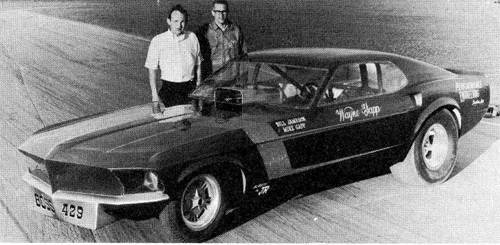Another pic of the Taxi from the Wide Web.
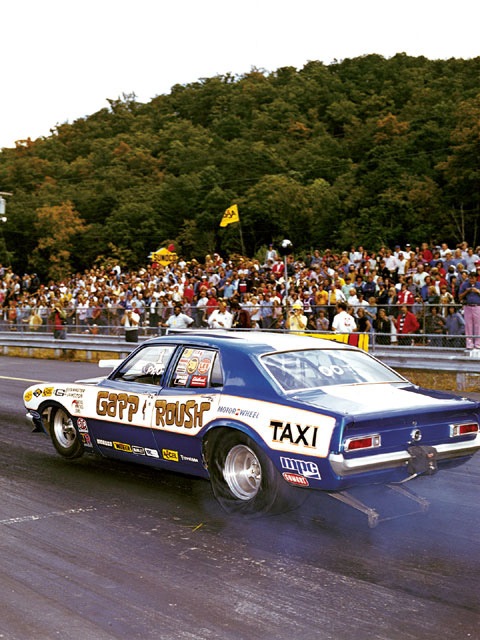
Another pic of the Taxi from the Wide Web.

By Alex Walordy
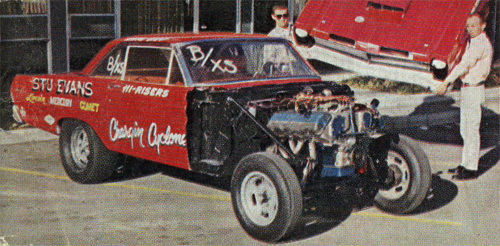
Perhaps you think of “high risers” in terms of tall FoMoCo high performance manifolds, but when Wayne Gapp stormsout of the hole, high riser means a six-foot wheelie. A low riser would be just a two foot wheelie. In case you believe that this is just another exhibition machine, Gapp set an NHRA National record in B/Experimental Stock at Ubly, Michigan, with a sizzling e.t. of 10.24 seconds and 136.75mph, running on gas. Being wise in the ways of racing, he didn’t go hog wild in rewriting the record books, he just improved them a bit.
This leaves ample margin for running under the record, which he continuouslydoes with times that range from 10.02 on up to 10.05 in four consecutive runs at Cecil County. (He won, needless to say, with a top speed of 138.35 mph.) In Detroit, his home grounds, he goes a bit slower, 10.30 and 136, still well under the record. Now Wayne will be the first to tell you that this isn’t the result of single-handed effort, for the car is the pride and joy of the Hi-Risers Club, a group of Ford engineers with a knack for blending science and pleasure into hot machinery. There are about 12 members on the active list, and they range in specialty from carburetor men to stress analysts (the guys who figure out how to make pieces so they don’t break). Now talent isn’t necessarily synonymous with money, and so the Hi-Risers have decided against the nitro can and the hydrazene. They are content with running gas and setting records with their funny Comet.
This Comet, to give credit where credit is due, was built by George Delorean and was part of the Mercury drag racing team in ’65. At the end of the season it changed hands and classifications. It also changed from an impossible traction problem into a very successful funny car. The Comet was originally built for a stock 115-inch wheelbase but the rear wheels were moved forward 13 inches.
The resulting 102-inch wheelbase led to violent wheelies and so the front wheels were moved forward 3 inches and the rear wheels back 3 inches, bringing the wheelbase to 108. We might add that the supports for the rear traction bars are made with two removable extension pieces, so that when traction is needed the rear can be moved forward by discarding the spacers.
These simple changes in static weight distribution were enough to transform the car into a winner. The front suspension is pretty unique in its own right and credit for it goes to George Delorean, who installed it just shortly before handing the car back to Mercury. The quarter eliptic springs are clamped to the flat bottom of the frame rails by means of U bolts. The bolt that holds the three leaves together on each side pilots on a drilled hole in the frame. One clear-cut advantage is that the entire front part of the frame was simply discarded, saving considerable weight.
In fact the engine now juts out from the front of the car like an air-cooled mill in front of a Piper Cub. It’s very easy to alter the wheelbase and the location of the front axle since all it involves is drilling new pilot holes for the springs and sliding them forward or back. The frame curves up slightly at the spring base and as the springs bend upward they follow the contour of the frame. Simultaneously the free end of each spring shortens and therefore stiffens, so that the pan and pipes are well protected by the increased spring rate when going over bumps on a rough return road.
On the other hand when the car rises the effective length of the spring increases lowering the spring rate. This in turn makes the car rise higher and helps get the wheelies started. The chrome moly straight axle was built by Logghe Stamping and fitted with early Ford spindles. It has received some additional reinforcement in the center to keep it from bending up because of the wheelies. In fact one of the problems with using the quarter eliptic springs is that they are placed fairly close together, leaving the unsupported ends of the axle to act with considerable leverage when the car bangs down. In addition to being located by the leaf springs, the axle is also positioned by a pair of radius rods.
The steering includes an Econoline steering box fitted with an extra long Pitman arm. A small Volkswagen steering damper prevents the harsh caster action from translating itself into a shimmy. The front shocks are neat looking Autolite raee units which do not offer an up-lock action. The up-locks are avoided for several reasons. First, there are clearance problems and then also the wheelbase has been altered so that starting line traction is not a problem. Then too, for high speed stability it’s better to have the car down rather than up.The front end is fitted with 6.70 x 15 nylon Firestones, that have been suitably worn off on the sides and are run at 50 to 60 pounds pressure. Look into the trunk and you’ll find a pair of 6-gallon tanks, one for fuel and the other for cooling water. This, together with a 100-pound battery, provides ample ballast. Next year when maximum class weights drop from 2600 to 2400 pounds in NASCAR, but remain at 2600 in NHRA, there will be some quick trimming in battery size and cooling capacity. The rear suspension is a reasonably stock Ford racing design with traction bars welded to the axle and its only unique feature is the quick wheelbase change we mentioned above. A pair of airlift bags are run at 15 pounds per square inch and allow quick tailoring of the rear suspension action. The bags will come into their own next year in helping compensate for weight changes between NASCAR and NHRA meets.
Considerable science has been devoted to the engine, some of it quite normal and some out of the reach of the ordinary rodder. The engine begins on a budget with the old style single overhead cam block that uses an outside oil return from the heads back to the crankcase. Clearances are just.002 inches on the mains and .0025 on the rods, tighter than most other people run them. The bearings range from Federal Mogul to Cleavite.
The Ford block has two oil relief valves, one at the pump and the other one inside the block. This results in a closer control of the oil pressure. Here the block oil pressure has been upped to 100 psi which is quite high and makes it mandatory to use the Ford racing filter. Any other filter would promptly blow up under this pressure. To improve the oiling, grooved upper and lower mains are used. (Grooved uppershells are used both top and bottom) Most drivers have gone to aluminum rods for heavy duty sohc use while the Hi-Risers have stayed with steel rods and learned to make them live, and here comes a bit of science that is unusual. Instead of just torquing the rod bolts and being at the mercy of any errors in torque wrench readings or bolt rig, they are miked to check the bolt stretch. The reason for torquing any bolt is to determine how tightly it goes in, but the final effect of the torquing is to place the bolt under stress lengthwise to increase the clamping pressure and this in turn means stretching the bolt. Since the stretch is directly proportional to the clamping action, the sensible thing is to mike the bolt in its free length before tightening and then keep miking it as you torque down the bolt. These bolts are picked from batches that have been checked and tightened down to close to their yield point (when they begin to stretch). This is fine, we said, but how about the loading that comes on a bolt due to the inertia of the rod and piston? Doesn’t that immediately carry the stresses above the yield point and make the bolts stretch out like tired old rubber bands?
The answer is straight science. Since the engine rpm is kept up high, the stresses are applied and removed so fast that the bolt does not have time to yield. Also,not counting idle time, the car accumulates only six minutes of running at 8500rpm in about two months, hence good bolt life. The crankshaft damper was eliminated by similar reasoning-not enough time for the stresses to act.
The pistons are also stock Ford which, together with engine blueprinting, bring a 13:1 compression. Slightly deeper valvepockets provide enough clearance so that the cam can be retarded or advanced at will. The pistons have Perfect Circle Molybdenum filled top and second compression rings. These rings are barrel faced for a quicker break-in. The moly, too, seems very desirable in this application because it’s softer than chrome, seats more quickly, doesn’t scuff at high temperatures and is porous enough to carry its own oil supply. One of the things the Hi-Risers found out was that if the blow-by (leakage past the rings) is controlled by the rings, less heat gets down to the ring lands and they don’t cave in.
In the tune-up department, you’ll find that the two big four-barrel Holleys no longer have choke plates. A loop of copper tubing bridges the fuel bowl vents to prevent spill-over on acceleration. Also, bigger jets are used in both the primary and secondary barrels. When the throttle is popped, the manifold vacuum is high and the primary venturi vacuum also rises. To prevent the secondaries from just flopping open and bogging the engine, there is a small ball check that modulates the action and slows down the secondaries for more normal street or strip applications. Here, with the engine leaving the line at 5500 to 7000 rpm and going through the lights at 7600 to 8000, there is no need to slow down the secondaries and the ballcheck is removed.
The ignition system is the same Autolite transistorized unit that has been used on the Ford GTs at Le Mans and on the Ford Indy cars. It’s a breakerless unit with an 8-pole rotor that triggers magnetic signals and produces a spark that just won’t quit. It also offers an interesting form of engine speed control.
Phil Hazen, an electrical engineer who is a member of the Hi-Risers, made up a mechanical drive from the cam to the tach.The face of this tach has a small slot which is fitted with an adjustable stop. If the engine should overspeed, the tach needle pegs against this stop and completes an electrical circuit which cuts the ignition through a relay system. The exhaust header stacks are short and there is no collector, simply because the engine never sees a “low end” in the rpm scale. The Long twin-disc clutch follows the 70 same pattern as those released on the hot Comets last year. Lugs cast right into the flywheel drive the steel floater plate. The pedal pressure is quite low which gives the driver good control and the lightweight solid flat discs do not interfere with the shifting. Also, thanks to the twin-disc design, it’s possible to get away with small 10-inch discs instead of 11 inches, which further reduces the rotating inertia and helps keep shifting easy.
To further insure good, fast, snappy shifts, the Hi-Risers have tried two different approaches. One is to cut all the teeth off the blocker ring and also to remove every second tooth from the synchro sleeve and the corresponding teeth on the gears. This increases the chances of completing a shift by more than double since there is ample space for the dog clutch teeth to match.
Another system tested by the Hi-Risers has worked out quite successfully and involves less weakening of the parts. Here all the teeth are retained but the shift is made smoother by cutting three new slots in the blocker ring. In a stock machine,the blocker ring is designed so as to make the teeth meet head on and block the shift until speeds are synchronized by the clutch action of the blocker cone. By repositioning the slots, the offset between the teeth is reduced and as soon as pressure is applied,the teeth are ready to slide past eachother. Some blocker clutch action is retained and the shifts are less hard on the teeth.
The rear axle carries a 4.86 ratio and a 9·inch ring gear which has given no trouble. It is also equipped with heavy duty 31-spline axle shafts. To stop the machine at the other end of the quarter in the face of speeds that are pushing the 140 mark, the Hi-Risers installed sintered iron linings on the brakes. They are warmed up with a couple of touches before they are fully applied. In fact the stopping distance is short enough so that the chute seldom needs to be used. As usual in a machine campaigned by engineers, there is much thought given to small details, the ones that win races, and,the Hi-Risers are no exception. They also win regularly. Could it be that there is something to all that science?
This is from ’75.
The bits inside include a biography of the two principals, discussion of the vehicles and a few photos.
Cool.
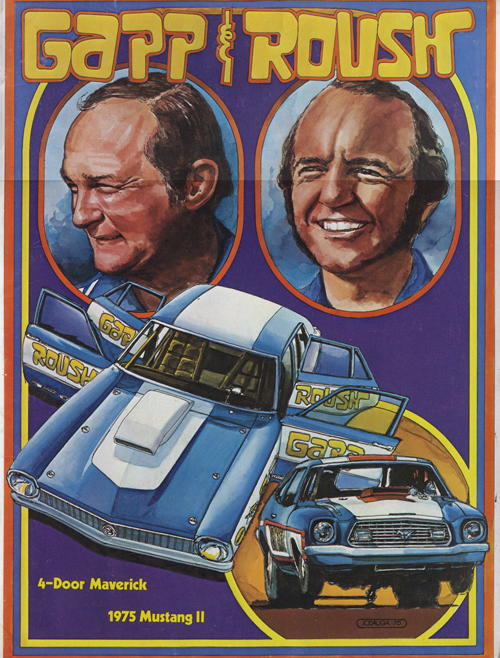
Maverick’s. Here’s the first one. Blue. The second was red. This one was pretty much a standard car that was tubbed, etc. The second was purpose built.
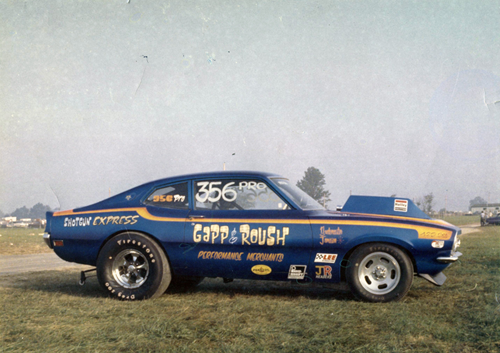
Here’s another nice from the Web. This is the 2nd Pro Stock vehicle. The first was a blue Maverick. That’s my Dad in the blue shirt on the right.
I told my Dad that this is a pretty sharp looking BOSS 429 powered MAVERICK!!
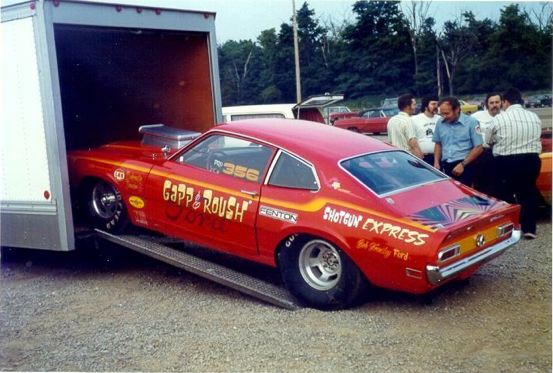
I’ve got a huge poster from this advertising campaign.
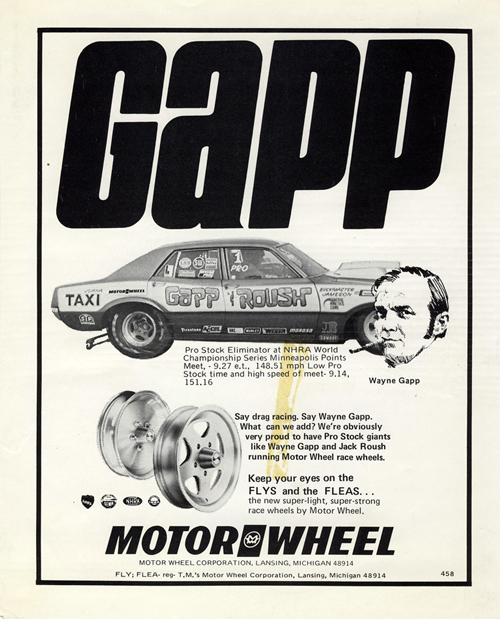
The Tijuana Taxi, owned and driven by Wayne Gapp. That’s Mr. Bill ‘Grumpy’ Jenkins in the other lane.
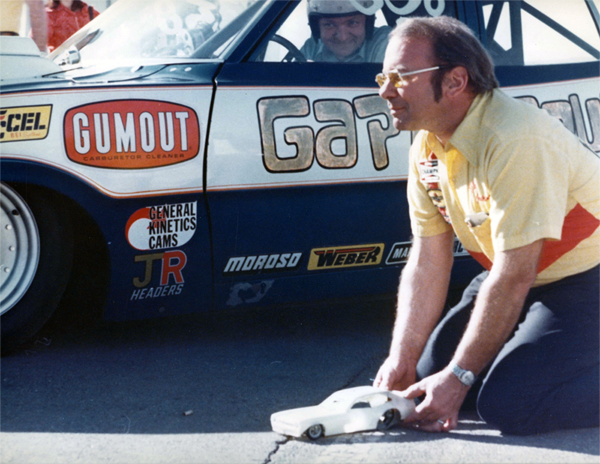
I titled this one “So you’re saying I have a chance?”.
Hard day at the track!
One of the cleaner pics that I’ve seen.
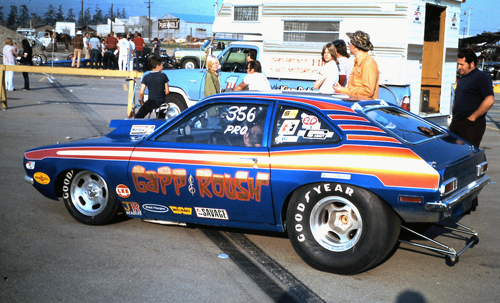
From the cover of ‘American Rodding’. Article to come.

The following was published in ‘Cars’ magazine in 1969. I am in the process of documenting some of this stuff and am going to use this article as the ‘template’ of how I will present this information on the Web. Clearly I need to get some design chops, captions on the images would be nice as well…
It’s a fun article…enjoy.
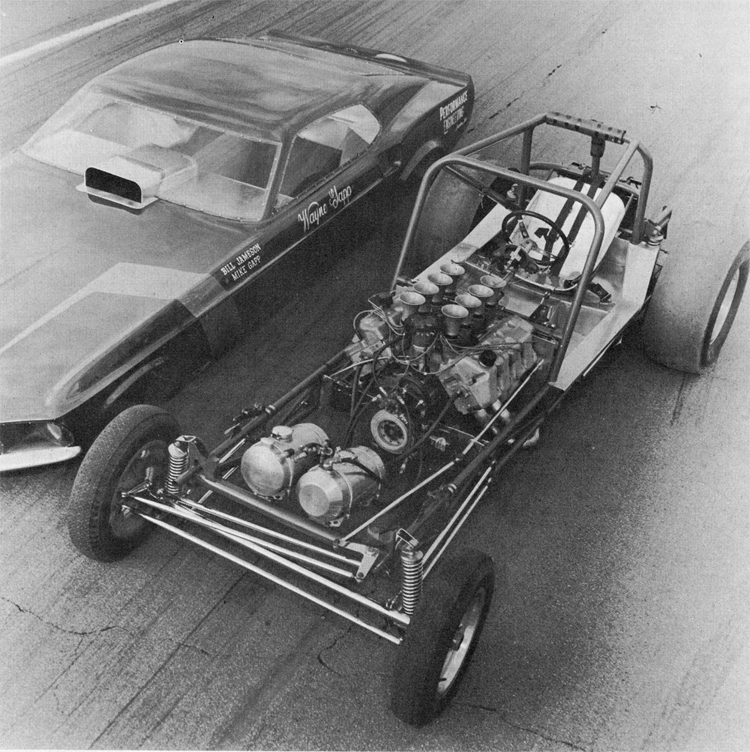
By Alex Walordy
There are only 24 hours in a day, and just a meager seven days in a week, so Wayne Gapp and Bill Jameson parcel out their time carefully. By day, they work at Ford Engineering in varying engine design functions. From Ford, it’s only a short drive to a little shop called Performance Engineering, also in Dearborn, Michigan. There they build Ford race engines. Then, of course, a man has to relax and that calls for a 429 Boss race car. Gapp and Jameson really wanted a blown fueler, but that looked like too much of a full time business in itself to be successful. Instead, they turned to a gas funny car, AHRA style.
The class rules are very strict; 430 cubic inches maximum, naturally aspirated and no less than 2000 pounds weight. End of rules! Since Gapp and Jameson are both interested in engine design and development, the freedom to make any changes they wanted fell right within their province. Also, the car stood a chance of becoming a winner without encroaching too much on their day and night schedule. The competition is fierce, with cars like Al Joniac’s Mustang, George Weiler’s Camaro, Earl Phillip’s ‘Baltimore Bandit’ and the ‘Banning Dodge Charger’ to cite a few. However, for having a brand new machine, Wayne Gapp hasn’t done badly at all. First run out, he turned 149 mph and posted a 9.2. Since then, there has been a consistent improvement in the car, as the little bugs get shaken out.
While the new Boss 429 is built strictly as an AHRA car with a 33 percent engine set back, moving the engine ahead to the 25 percent mark would make it possible to run in A/funny car under the NHRA banner. Since the current class is quite competitive and operates as a circuit, there is very little time between rounds and no chance to change engines or transmissions. In other words, to win you have to stay in running shape without breakage and the Ford pieces are turning the trick. In fact, Wayne feels that an 8.80 with a top speed of 160 is well within sight.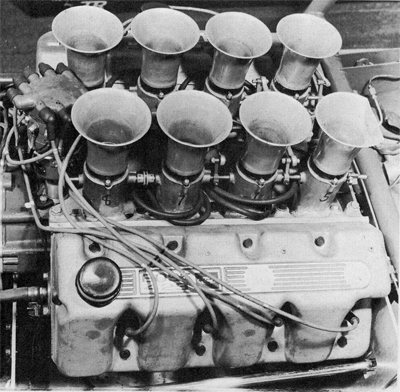
One thing about the Boss 429, it is distinguished by the biggest intake ports in the industry, and this doesn’t necessarily lend itself to high air flow velocity and great fuel distribution in a carbureted car. No matter, says Wayne, so he set up the engine to run with fuel injection at well above 7000 rpm. He leaves at 7500 rpm by dropping the hammer rather abruptly, and doesn’t allow the engine rpm to go much below 6000. In fact, Wayne and Bill Jameson couldn’t care less about what happens below 4000, since the engine never operates that slowly. End of air velocity problems.
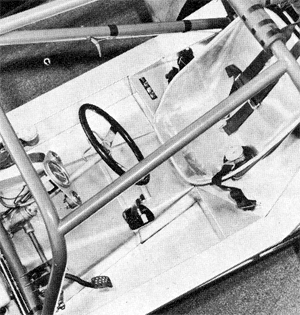
The Boss 429 is still a brand new engine and no one was in a position to supply an off-the-shelf fuel injection unit for it. However, there must be a benefit to having a pair of engineers on the job, for they promptly designed their own unit. Eight runners similar to those of the SOHC were cast, after which side and bottom plates were fabricated out of flat stock. The whole thing was shipped to Antieaux’s Welding, and heliarced, using the block and heads as a jig to keep everything in alignment. After some machining, which included rifle drilling the new manifold to accept throttle shafts and also boring the runners out for Hilborn throttle valves, the unit became ready made bolt-on assembly.
Wayne is already thinking, of course, about the next fuel injection unit that he will build, one with even more streamlined air passages. That one will consist of a series of independent intakes joined to a common base plate. It would be a lot easier to machine since all the pieces can be made individually on a jig. One advantage would be to eliminate the difficult rifle drilling of the throttle shafts. A fuel pump drive for the Boss 429 was just as unavailable as the injector manifold, so Wayne made up an aluminum cover which replaces the stock water pump and supports the Hilborn pump instead. A hex head mounted on the timing gear powers the Hilborn pump.
Pointing the nozzles upward against the air stream instead of twoard the valve imporoved the fuel break up, and also allowed more time for the fule to mix with the incoming air. Add to this a set of intake stacks designed to produce just 14 inches of tuned ram length from the valve to the top of the intake. This, plus a set of big 2 1/4-inch diameter header pipes which Bee Line engineering trimmed to a 30-inch length, tune the engine for peak rpm. Then, to fill in the upper end of the midrange and help the car leave harder, there is a seven-inch transition to a collector. Wayne is currently experimenting with optional collector lengths of different designs to see which one puts out the most usable power.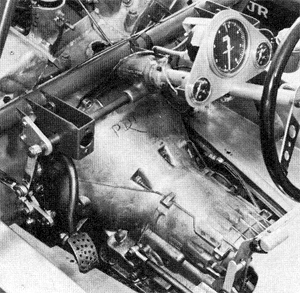
The 429 valve train is built for the steady grind on circle tracks, 500 miles at a clip and is to sturdy and to heavy for straight drag racing. Gapp was able to remove 100 grams at a clip by switching to think wall push rods, aluminum retainers, and thoroughly reworked rocker arms. Any excess material which didn’t add to the rocker’s load bearing capacity was ground off, and this includes a small area around the oil squirt hole. The standard valve latch adjusting screw and its lock nut look big enough for double warranty life on a Mack truck. Wayne Gapp go a hold of some raw rocker arm forgings and machined them for a light-weight 3/8-inch Chrysler adjusting screw. These lightening changes plus the stock tubular valves, and a special cam, brought the rpm limit up to 8000. Quite an achievement considering the kingsized intake valves.
To raise the compression, most people are content to cut the cylinder heads, and it probably works well enough in most engines except the Boss 429. As Gapp points out, there are four “O” rings for the cylinders, and nothing less than 21 “O” rings to seal off the various water passages. Any time you cut the head, all of the “O” ring grooves must be reworked since the Boss 429 is for all practical purposes a dry deck engine. Besides, the combustion chamber has two side sections taken out of the circle so the cutting of the head doesn’t remove as many cc’s as cutting the deck of the cylinder block, where the volume gain is based on full circle area. It is, therefore, no surprise that the heads are left alone, and that decking just .025 inches from the block deck raised the compresson to a comfortable 13-to-1.
Grand National rods may be heavier than the ones made for streeet use, but they’re also designed to go 500 full throttle miles, and at a quarter mile a shot, that makes for quite a few runs. Since they’re made of 4340 steel and fitted with half inch bolts, you can understand why they last. The 429 rod bearings are .860 inches wide, while the ones on the 427 SOHC only measured .740 inches across. At first glance an eighth of an inch may not look like much of a change, but it represents a 17-percent increase in bearing area, more than enough to guarantee good life. The two partners had quite a session using clay to check the piston to cylinder head clearance and then doing a little file work here and there to work out the close spots.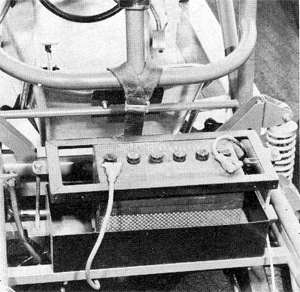
The stock oil pan was deepened two inches and fitted with bustles on each side. This brough the capacity up to ten quarts, including the filter, without cutting to far in on the ground clearance. The neat street type engine oil pan baffle was left unchanged, but the sump pick-up was dropped closer to the new bottom. Moving up from there, you’ll find a race-type two-gear pump selected for its ability to digest metal particles. This pump, incidentally, is different from the more convential Gerotor pump released on the Cobra Jets and Super Cobra Jets. As an added precaution, the pressure relief spring was shimmed to increase the oil pressure.
As far as Wayne Gapp is concerned, the name of the game is getting out of the gate, and there isn’t enough power available on gasoline to turn that trick with a torque converter. Instead Wayne and Bill Jameson fell back to an old stand-by, a dual disc 427 drag racing clutch, complete with a 40-pound flywheel, which they had salvaged out of their old ’66 AFX Comet. It worked then and it still does now. Now, a clutch may be great, but both Wayne and Bill are still sold on the fast consistent shifts of an automatic. However, adapting the C-6 automatic to the 429 engine proved to be something of a problem because, for one thing, the starter had to be moved to clear the flywheel. Then, some of the bolt holes and dowels no longer fit. Now, both the engine and the transmission are fastened to the quarter-inch supporting bulkhead. Helicoils (small coiled steel wire inserts) were threaded into the bulkhead so that frequent disassembly wouldn’t strip the aluminum. Three of the original bolts go straight through from the transmission to the engine while the rest tie in via the adapter. The C-6 has been thoroughly reworked to beef it up and also convert it to a full manual shift. Topping all of this is a logghe ratchet-type shifter. A 14 5/8-inch drive shaft will never win any prizes for length and even this space had to be carved out the hard way by converting the trans to use a short tail shaft. A brand new cross member, retained by just two bolts, cuts down on the amount of work it takes to remove the transmission.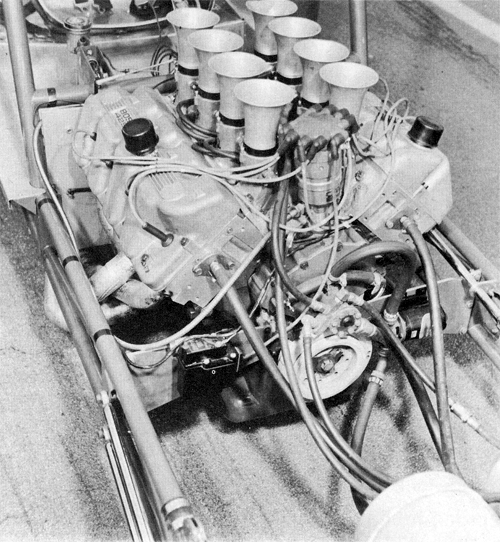
Since Wayne’s machine is not straining at 150 mph, even with 4.57 gears, you can see that the engine’s rpm capability is not neglected. Logghe supplied the narrowed rear, the shortened axles and teh set of drum brakes out of a 1968 Fairlane station wagon. The drums proved more than adequate in stopping the car, have less drag than discs and also offer a good holding power on the starting line when preloading the clutch. Rubber includes a set of 12.00 x 16 M7H’s mounted on 10-inch Cragars and, so far, the best tire pressures have been between six and eight pounds. To cut down on rolling resistance up front, Wayne picked a set of radial ply 5.60 x 15 Pirellis mounted on four-inch Halibrand rims and pumped up to rock hardness.
Wayne and Bill operate on a tight budget, and instead of going all out for a brand new frame they picked up a used Logghe frame in good running shape from a well-known Ford racer. It offers 120-inch wheel base, plenty of stability and ample room for the big engine set-back–it’s nice to play the percentages but you still need a certain amount of inches to accomodate the driver.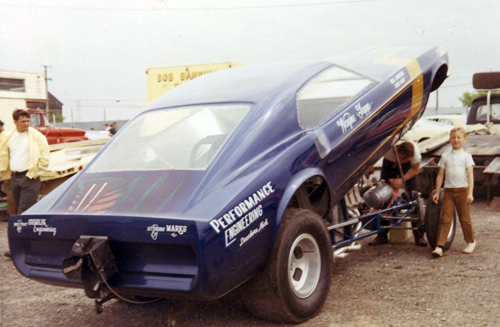
Everyone is entitled to their little secret and Wayne has been doing a lot of experimenting with frame wedging and suspension units to get the most powerful gate job. After campaigning what amounted to a wheelie machine for a couple of years, Wayne now feels that picking up the front end too much just hurts the et. “You want to go forward, not up” Mind you he doesn’t mind carrying the front wheels and putting most of the load on the rear ones, but he still wants to handle well and goin in a straight line.The wheelie casters have been brought down close to the ground and steadided with a cross-piece. This gains quick contact with the ground as soon as the nose begins to lift, and avoids the sudden changes in loading. For instance, if the front end rears up hard enough, it can then jerk the rear wheels off the ground as well, while limiting the rise gains top traction.
Right now the Boss Mustang is around 70 pounds over its 2000-pound liit, but since 780 lbs of the weight is taken up by the engine and flywheel alone, there isn’t too much more lightening that can be done. One step in the right direction was to use a lightweight 125-pound Shedlik body out of Shedlik Engineering in Inkster, Michigan.
Also, Tom Smith of Wolverine Diesel contributed some very light aluminum work with cleverly formed cut-outs that are flanged over to retain stiffness while doing away with extra metal. A thirty-pound battery, complete supporting brackets will be eliminated from the rear of the car as soon as Wayne converts to an outside 24-volt battery for starting purposes. Neither partner is very happy with that because when you travel alone to a strip, that outside battery can be a nuisance. Wayne and Bill are even less happy with the prospect of chucking the cooling system, especially since a gasser usually runs hotter than the fuelers they have had in the past.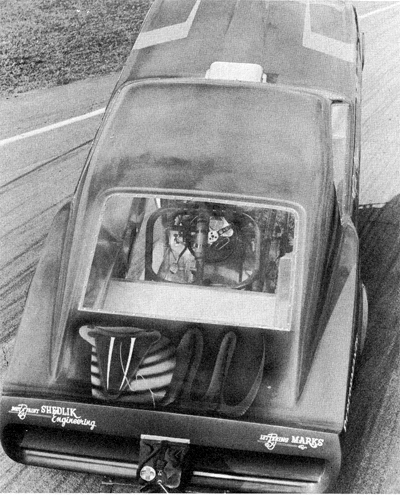
Of course, we left the best for last, an unreal paint job by Paul Shedlik, complete with a wild Cobra baring his fangs from the tail end of Gapp’s machine. In a tight race, when the competition is in hot pursuit, that Cobra has been known to hiss, breathe fire, turn on the steam and flat streak through the lights.
